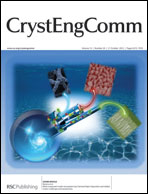Seven novel alkaline earth (AE) metal-sulfonate complexes constructed from ortho-hydroxyl arenedisulfonic acids, [Mg2(H2L)2(H2O)4]·8H2O (1), {[Ca(H2L)(H2O)]n·3nH2O} (2), {[Ca4L2(H2O)12]n·7nH2O} (3), {[Sr(H2L)(H2O)]n·3nH2O} (4), {[Sr2L(H2O)4]n·nH2O} (5), {[Ba(H2L)(H2O)2]n·2nH2O} (6), and [Ba2L(H2O)4]n (7) (H4L = 2,4-dihydroxyl-1,5-benzenedisulfonic acid), have been synthesized and characterized by elemental analysis, IR, TG, PL, powder and single-crystal X-ray diffraction. Complex 1 is a dinuclear unit which is extended by intermolecular hydrogen-bonding interactions into a 3-D supramolecular network. Complexes 2, 4 and 6 exhibit 2-D hybrid layer motifs formed by phenyl rings bridged by infinite 1-D M–O chains, in which the H2L2− dianions act in different μ4:η6 (complex 2), μ4:η7 (complex 4) and μ4:η8 (complex 6) coordination modes. In comparison, complexes 3, 5 and 7 exhibit 3-D pillared layered networks formed by phenyl rings bridged by infinite 2-D M–O layers, in which the L4− tetraanions act in different μ6:η9 (complex 3), μ6:η9 (complex 5) and μ8:η14 (complex 7) coordination modes. The interspaces of the layer motifs in complexes 2, 4 and 6 are filled by lattice water molecules, and the channels in complexes 3 and 5 are also filled by lattice water molecules. It should be noted that the coordination modes of the sulfonate group in complexes 3 (μ3:η3), 4 (μ2:η3), 5 (μ4:η5), 6 (η2 and μ3:η4) and 7 (μ4:η5) are reported for the first time in the corresponding AE-arenesulfonates. The structural diversities and evolution of these complexes can be attributed to the nature of the metal cations, coordination modes of the sulfonate groups and the hydroxyl groups induced by the pH value. The solid-state luminescent properties demonstrate that complexes 2–7 exhibit violet emission at room temperature and the luminescent emission intensities of the H2L2− containing complexes are evidently stronger than those of the L4− containing complexes. Moreover, the complexes can sensitize Tb(III) ion to exhibit its characteristic green emission.


 Please wait while we load your content...
Please wait while we load your content...